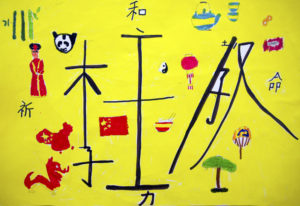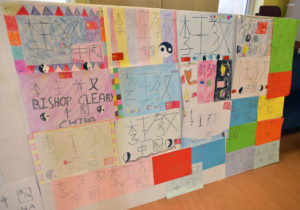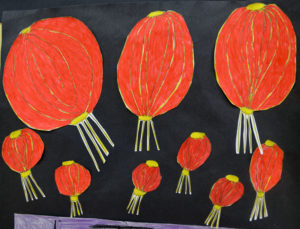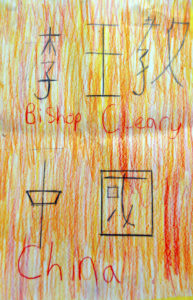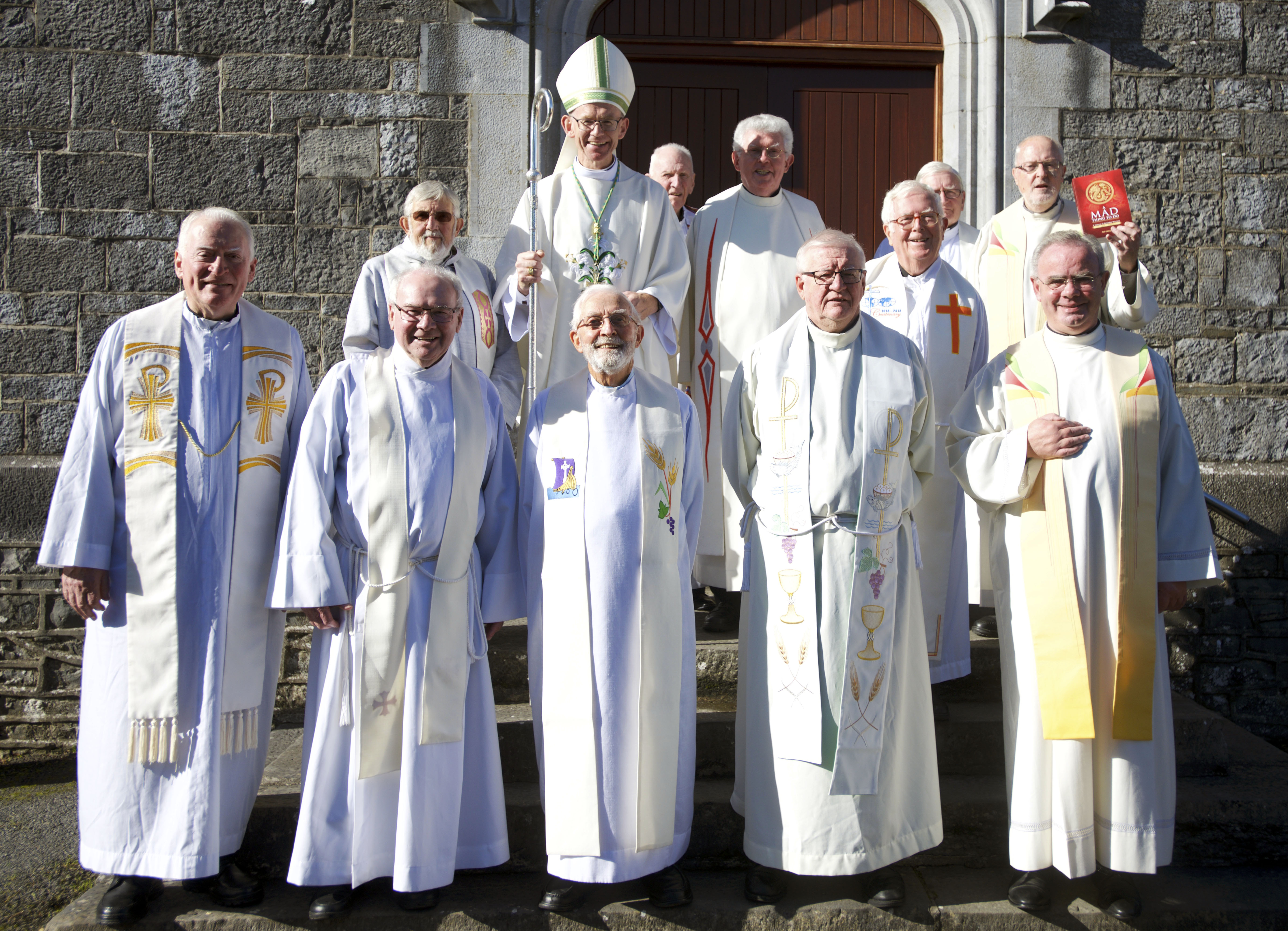A new plaque commemorating Columban missionary Bishop Patrick Cleary was blessed and unveiled at St Michael’s Parish, Kildysart by Bishop Fintan Monahan of Killaloe at a recent Mass to mark the centenary of the Society.
In his address, Regional Director for the Columbans in Ireland, Fr Pat Raleigh, who was ordained by Bishop Cleary stated, “As a Missionary Society we were truly blessed by having Bishop Patrick Cleary as one of our very illustrious members. How appropriate that he was from Kildysart.”
Fr Raleigh thanked Bishop Cleary’s relatives for attending the ceremony. “I say a very sincere thank you on behalf of the Columbans for having gifted such a wonderful missionary to the Society.”
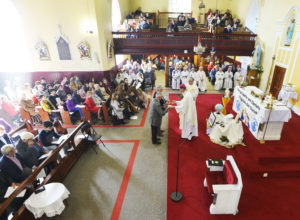
All photos courtesy of Columban Mission Images.
He also paid special tribute to Fr Tom Cusack from Ballycotton who was killed in Korea in 1950.
“It is indeed very appropriate that Fr Tom Cusack’s niece, Stephanie McNamara, and other relatives are with us today. Stephanie is part of the choir. It is our hope and wish that our Columban Martyrs will be canonised one day. To the relatives of these martyrs we say many thanks.”
Addressing Bishop Monahan, he thanked him for acting as celebrant at the centenary Mass.
“There has been a very long association between the Columbans and the people of your former Archdiocese of Tuam. One of our co-founders, Fr John Blowick was from the Tuam Archdiocese,” Fr Raleigh said.
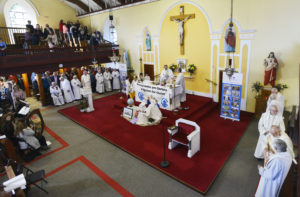 He also asked Bishop Monahan to convey the Columbans’ gratitude to his fellow bishops for their very kind words at their recent Autumn gathering in Maynooth.
He also asked Bishop Monahan to convey the Columbans’ gratitude to his fellow bishops for their very kind words at their recent Autumn gathering in Maynooth.
In the statement, the Irish bishops said, “In this their Centenary year, the Bishops acknowledged with prayerful gratitude the great worldwide contribution of the Missionary Society of St Columban which was founded as the Maynooth Mission to China in 1918. The Bishops praised the work of the Columban Missionaries who were at the forefront of teaching about reconciliation and justice, caring for the earth, our common home and pointing out how the poorest people of the world suffer most from the throwaway culture of greed and waste.”
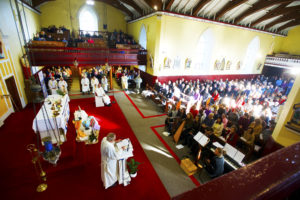 Bishop Monahan told Columbans.ie that through the association between St Jarlath’s College in Tuam and the Columbans, he himself felt connected to the Society.
Bishop Monahan told Columbans.ie that through the association between St Jarlath’s College in Tuam and the Columbans, he himself felt connected to the Society.
“There was a tradition of Columban priests in St Jarlath’s and the co-founder, Fr John Blowick, attended the college. Shrule was only out the road – so there was always a great sense closeness to the Columbans. A number of years ago I’ve visited a classmate who is a Columban missionary in Pakistan – Fr Tomás King.”
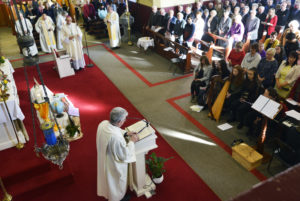 Speaking about the Irish Church’s missionaries, Bishop Monahan said there had always been a great missionary tradition in Ireland, going back to the earliest days – “the time of St Columbanus and ‘Peregrinatio pro Christo’ which we saw on the banner in the church today”.
Speaking about the Irish Church’s missionaries, Bishop Monahan said there had always been a great missionary tradition in Ireland, going back to the earliest days – “the time of St Columbanus and ‘Peregrinatio pro Christo’ which we saw on the banner in the church today”.
“Then there were the great missionary societies and the great tradition of the Columbans. That is part of our tradition, the many women and men who left Ireland’s shores to go on mission. I was talking to Fr Tom McGrath from Labasheeda and he recalled how when he initially went out on the missions, he travelled with a plane full of missionaries – a full plane packed with missionaries. That was the golden era of the missionaries but there is still a great sense of it. I was out with Trócaire in Malawi and in Nairobi recently and so many lay people are doing fantastic work through the auspices of groups like Trócaire and different missionary societies. It is inspirational to see that – I would hope that would continue long into the future.”
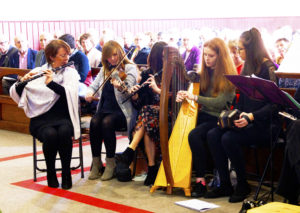
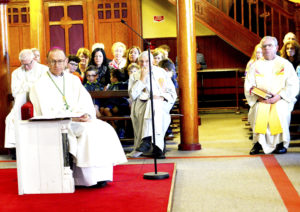
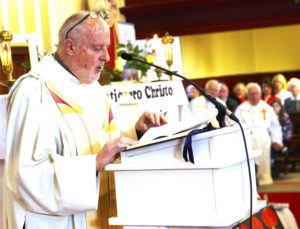

John O’Brien is married to Mary Cleary from Cahircon, a niece of Bishop Patrick Cleary’s. He explained to Columbans.ie that Mary had been looking forward and planning for the Centenary Mass and the gathering all year but then she broke her hip and so was unable to attend.
 He recalled how the couple met Bishop Cleary “when he was back from China” fifty years ago when they were on their honeymoon. “We went to Dalgan Park to see him. He had recovered very well by that stage, but he was moving on in years.”
He recalled how the couple met Bishop Cleary “when he was back from China” fifty years ago when they were on their honeymoon. “We went to Dalgan Park to see him. He had recovered very well by that stage, but he was moving on in years.”
John and Mary’s son Donal O’Brien also attended the Mass in Kildysart. He recalls growing up to the stories about Bishop Cleary and his arrest in China. “There are pictures of him having the first meal after coming out from jail surrounded by nuns; you can see he is very thin – he had a tough time.”
He and his parents still maintain the link with the Columbans and often drop into Dalgan Park when they are passing. He found the history spoken about at the Centenary Mass in Kildysart interesting because “it seems Bishop Cleary would have influenced the buying of Cahircon, I didn’t realise that.”
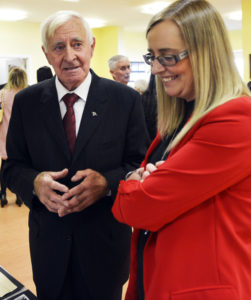 Sr Frances Cleary is a grandniece of Bishop Cleary’s. “My father was his nephew,” she explained to Columbans.ie. She joined the Mercy Sisters in Gort in 1957 and was received into the congregation in 1958.
Sr Frances Cleary is a grandniece of Bishop Cleary’s. “My father was his nephew,” she explained to Columbans.ie. She joined the Mercy Sisters in Gort in 1957 and was received into the congregation in 1958.
“Bishop Cleary was invited to my reception, so I have a photograph of him at my reception in Gort. After he came back from China I met him many times – I visited him in Dalgan and I was at his funeral.”
She recalls ‘Uncle Pat’ as kind and with a good sense of fun. “He was very friendly and had a love of life.” On one occasion that he came to visit Frances and her brother, the two had been out picking fresh mushrooms and when they came back they cooked them for him and he was delighted as he didn’t get to eat freshly picked mushrooms in China.
Sr Frances’ brother Pat also attended the Mass in Kildysart. “He was a hero. A very humble man who made very little of all the experiences he had had. He didn’t come home for 21 years as it was the time of the Communists in China.”
 “I remember one Christmastime, he was staying in Cahircon convent and he was invited over to the Cleary’s for dinner. We were all there. It was the day after Christmas day and the Wren boys were about and he came up to the gate and he had his pants pulled up with the white ‘long johns’ showing, and he was hitting a tin can like a wren boy…he had such a good sense of fun.”
“I remember one Christmastime, he was staying in Cahircon convent and he was invited over to the Cleary’s for dinner. We were all there. It was the day after Christmas day and the Wren boys were about and he came up to the gate and he had his pants pulled up with the white ‘long johns’ showing, and he was hitting a tin can like a wren boy…he had such a good sense of fun.”
“He was instrumental in a lot of the purchases of the places that the Columban had. Cahircon was where the priests learned the Chinese language – that’s where he was learning it himself. In 1931 he went to China and in 1952 he was expelled – he was under house arrest for about 10 months. He was skin and bone. I saw him when he came home, and I was shocked. Before he got back to Ireland he had gone to America for some treatment, so he already had a certain amount of treatment before we saw him, but I was still shocked.”


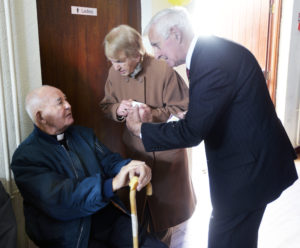
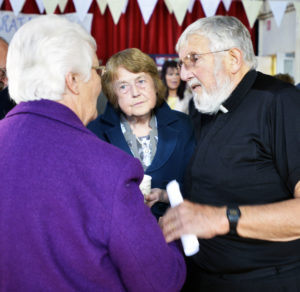
Stephanie McNamara is a niece of Fr Tommy Cusack who was killed with Fr Pat Brennan and Fr Jack O’Brien in Korea in 1950. She attended the Mass in Kildysart with her husband is Tom. She has five children and ten grandchildren.
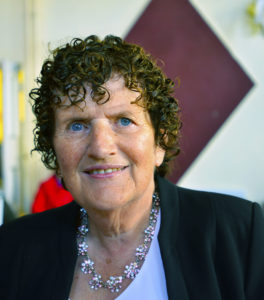 Fr Cusack was born at Ballycotton, Co Clare, in 1910. In 1949, he was appointed Vice-Director of the Region of Korea. He was stationed in Mokpo when the North Korean army overran most of South Korea, including Mokpo. He was taken into custody along with Fr Pat Brennan and Fr Jack O’Brien. All three are presumed to have perished in the general massacre of prisoners at Taejon on the night of 24 September 1950.
Fr Cusack was born at Ballycotton, Co Clare, in 1910. In 1949, he was appointed Vice-Director of the Region of Korea. He was stationed in Mokpo when the North Korean army overran most of South Korea, including Mokpo. He was taken into custody along with Fr Pat Brennan and Fr Jack O’Brien. All three are presumed to have perished in the general massacre of prisoners at Taejon on the night of 24 September 1950.
Asked what the Mass in Kildysart and the commemoration of Fr Cusack meant to her, Stephanie McNamara told Columbans.ie, “It means everything to me. I think it is fearfully important to remember the martyrs – all 24 of them and to pray for them. I feel my generation is getting older and it needs to be passed on.”
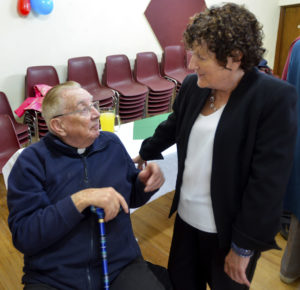 Stephanie’s “abiding memory” of her uncle is of meeting him on the last day of his holidays before he went back to Korea.
Stephanie’s “abiding memory” of her uncle is of meeting him on the last day of his holidays before he went back to Korea.
“We were all in Tramore where my grandmother lived and there was a big stone at her door; my brother and I were sitting on it and he climbed out over us and he turned back, and he said to my brother – ‘will you come to Korea and be my curate’. Jim was two. I just remember the two of us sitting there and these big legs coming out over us – that was my last memory of him.”
When the news emerged that the three priests had been killed, Stephanie’s grandmother, mother and her mother’s siblings grieved over the fact that the three bodies had been thrown into a disused well and they were never found.
“In 2013, I went to Korea to the place where that well was. They were put in the well in 1950 and in 1952 they were taken out and they were buried on the side of a hill along with a lot of other people. But then in 1996 that land was earmarked for development and so all the bones were removed. Relatives of those who were buried there were brought in and the bones were all laid out. A man took bones to represent the three priests, but he couldn’t get a church to take them until 2008 and so for 12 years he kept them in his garden. In 2008, there was a burial in a cemetery in Taejon.”
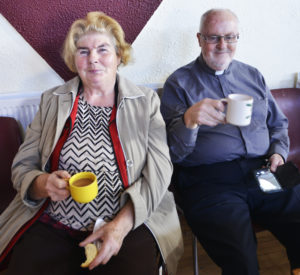 “If my grandmother had known that they were taken out of the well and put into a grave, she would have been a lot happier. We are happy now that this has happened.”
“If my grandmother had known that they were taken out of the well and put into a grave, she would have been a lot happier. We are happy now that this has happened.”
“The priests who were in Kwangju told him to get out, but he decided to stay. We have a letter explaining that this is what he chose to do and wanted to do. A priest called Fr Michael O’Connor was leaving Korea and he [Fr Tommy] said give this message to my mother. So, Fr Michael wrote to Granny and explained it to her. We have the original letter.”
 As to her children and their knowledge of the heroism of Fr Tommy, Stephanie says they “are blue in the face” with the story. Her son Ross and her daughter Tara travelled with her to Korea in 2013. Initially they went just to make sure she was ok but as they learnt more “they really got into the story”.
As to her children and their knowledge of the heroism of Fr Tommy, Stephanie says they “are blue in the face” with the story. Her son Ross and her daughter Tara travelled with her to Korea in 2013. Initially they went just to make sure she was ok but as they learnt more “they really got into the story”.
The power of Columban heroes to inspire a younger generation was apparent from a brief conversation with Yvonne Cleary, a great-grandniece of Bishop Cleary.
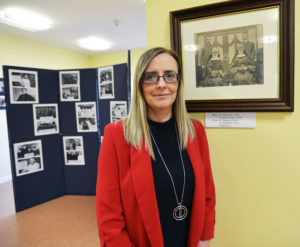 Despite the intergenerational distance, she told Columbans.ie, “It is something that we have grown up with over the years, we always knew that Bishop Cleary came from where we were born – one of the bedrooms at home would have been named ‘the Bishop’s room’.”
Despite the intergenerational distance, she told Columbans.ie, “It is something that we have grown up with over the years, we always knew that Bishop Cleary came from where we were born – one of the bedrooms at home would have been named ‘the Bishop’s room’.”
My Dad got married in 1970 and he [Bishop Cleary] was invited to their wedding but he was too ill to travel; he passed away three months afterwards.”
“I grew up in the house where the bishop was born. We grew up with photographs around and a lot of his work, memorabilia, his diaries – he was very evident, and my parents would travel up to Dalgan Park for his anniversary when they could.”
Yvonne has two older brothers and her brother Tom said a few words in St Michael’s during the centenary Mass on behalf of the Cleary family.
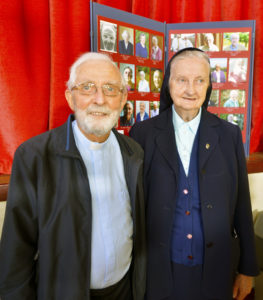 “All three of us would be very steeped in the history of Bishop Cleary, as are our cousins who travelled from Cork today and our cousins who came from Dublin and all over Clare. The bishop is important to all of them although they are not living in the community here in Kildysart.”
“All three of us would be very steeped in the history of Bishop Cleary, as are our cousins who travelled from Cork today and our cousins who came from Dublin and all over Clare. The bishop is important to all of them although they are not living in the community here in Kildysart.”
Of the blessing and unveiling of the plaque commemorating Bishop Cleary she said, “It is such a huge honour that he is recognised, not just by the Columbans but by the community here. We live a mile from Cahircon, so the fact that the bishop came from our community and has been recognised – it is a very proud day.”
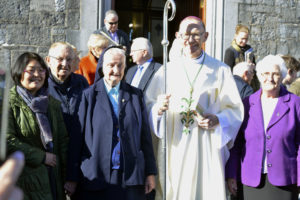
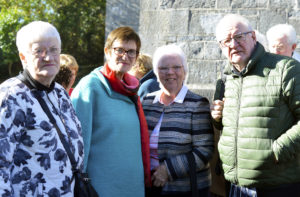


John Joe Cleary, Yvonne’s father, told Columbans.ie, “It means a lot to celebrate Bishop Cleary’s life and the centenary of the Columbans.”
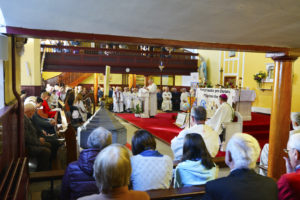 “He was my granduncle. I was nine years of age when he came home after he was expelled, it was 1953. The family had been fearful for his life, but they were delighted when he got out – he did stay until the end – he made sure that all the rest of them were gone before he left.”
“He was my granduncle. I was nine years of age when he came home after he was expelled, it was 1953. The family had been fearful for his life, but they were delighted when he got out – he did stay until the end – he made sure that all the rest of them were gone before he left.”
“He was so gentle. He would come over the road on a Sunday walking and we would go back a bit of the road to meet him and walk with him – he was a lovely presence. I think he is a saint – I don’t know if he will be canonised, but I think he is a saint.”
